About VACCINE
As the amount of data gathered during a crisis can be crushing if not managed correctly, visualization is critical to all mission areas of decision making, sustainability, resiliency, public safety and security. In the event of a catastrophe such as a chemical spill, natural disaster, disease outbreak, or terrorist attack, information will be coming from many sources, such as camera images, data from sensors and simulations, text documents from police and healthcare agencies, and social media. In order to make practical use of this data, decision makers, safety officials, first responders, and members of the Homeland Security Enterprise need effective methods of processing and analyzing to turn this data deluge into actionable information.
Established in July of 2009, the Visual Analytics for Command, Control, and Interoperability Environments (VACCINE) Center is a Department of Homeland Security (DHS) Emeritus Center of Excellence in Visual and Data Analytics. VACCINE’s mission focuses on creating methods, tools, and applications to transform vast amounts of data into useable and actionable information for a range of applications, from public safety and homeland security to logistics planning to sustainability and agriculture.
Center strengths include:
- Integrated program of research, education, and outreach: VACCINE’s work spans the disciplines of visualization and computer graphics, engineering, computer science, geographic information systems, cognitive psychology, information technology, and emergency management and public safety.
- Broad network of schools: VACCINE is the headquarters of a network of 38 partner universities, both domestic and international, dedicated to turning massive data into actionable knowledge through innovative visual analytics techniques.
- Extensive end-user community: Our Center has a strong, collaborative history of and experience in working with end-users to solve their real-world problems:
- VACCINE has worked with more than half of the agencies within the Department of Homeland Security and has MOUs (memorandums of understanding) with more than 50 different law enforcement agencies.
- VACCINE has actively engaged communities, growers, producers, and sustainability associations to develop roadmaps and transition science and technology into economic and environmental sustainable solutions across the U.S. and in South America.
- This community of end-user collaboration results in VACCINE’s research producing robust tools that are currently in use by law enforcement, first responders, and homeland security personnel across the country.
- Transitioning technology to general users: VACCINE transitions technology and tools from the research lab to local, statewide, and national users, with lasting impacts. For example, the U.S. Coast Guard has implemented cgSARVA, a search and rescue visual analytics tool developed by VACCINE, for agency-wide use. Since its implementation, cgSARVA has been used to reduce swimmer deaths, optimize patrol schedules, and save the Coast Guard hundreds of millions of dollars in resource allocation and disaster management.
- Educational outreach: VACCINE works to educate the next generation of homeland security professionals, first responders, and sustainability researchers on the power of visual analytics and advanced computational tools, enabling them to use the massive amount of data they will face in their careers to make effective decisions.
VACCINE: Visual Analytics for Command, Control and Interoperability Environments


